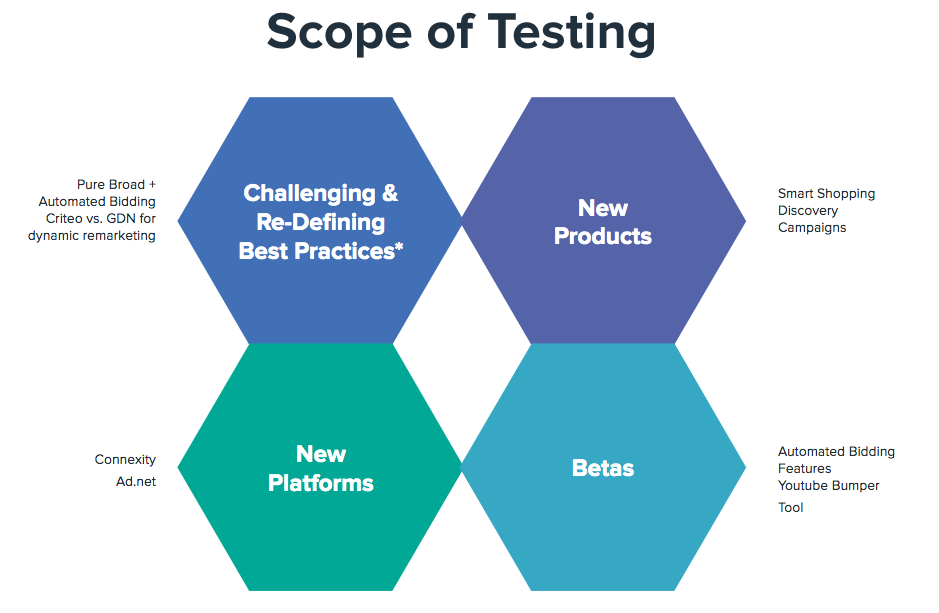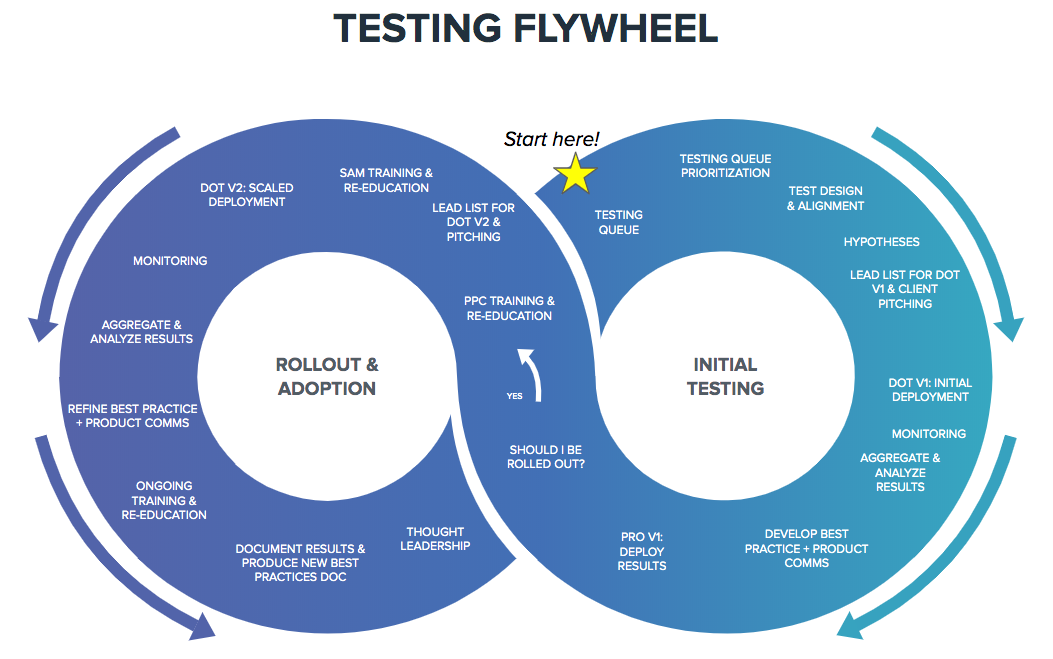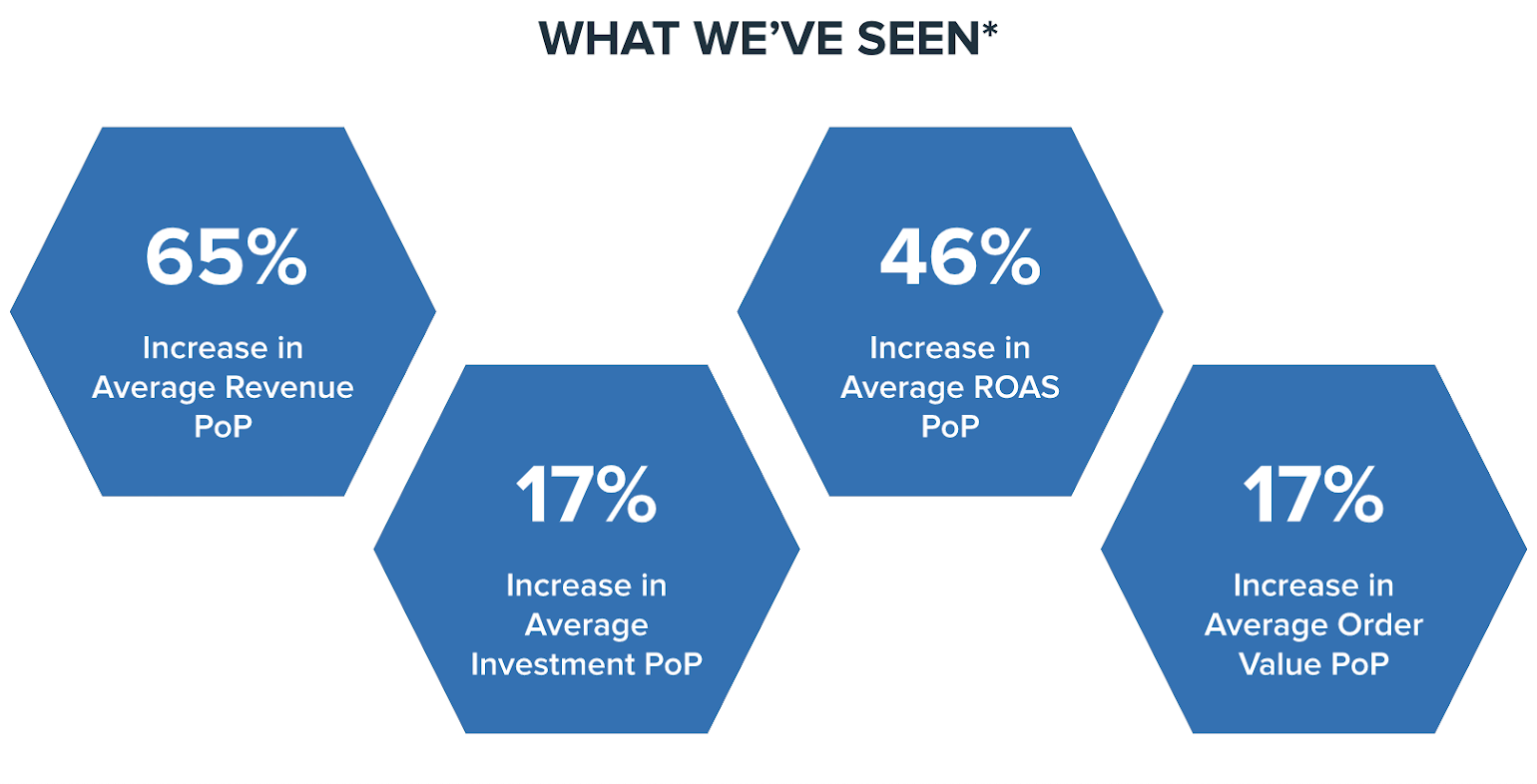At Wpromote, we’re constantly looking for opportunities to grow our clients’ digital footprints and to improve efficiencies among what we already do on Google, Bing, and other partners. Since we’re a Google Premier Partner, we also get early access to new products and betas before many other agencies and advertisers.
When there’s a new product, new beta, or new idea, we first conduct each test with a small group of clients and then expand to other clients only if initial testing is successful. By testing in a phased approach, we ensure we’re carefully considering which clients are the best fit for the test. Of course, not every test or every idea is applicable across our client portfolio; we strategically limit some tests to certain verticals or business types, so we only test for relevant clients.
Mastering the Test & Learn Approach: A Step-by-Step Guide
Since we have hundreds of clients of various sizes and across verticals, it’s critical to coordinate testing across our full paid media marketing team so we can learn from each other and scale our wins. Communicating across teams is important for any brand testing new ideas; coordinated testing ensures you don’t repeat unsuccessful tests or continue testing ideas you already know don’t work.
Here’s the general framework we use to figure out which ideas drive results and ROI.
1. Understand the importance of paid media testing
Any effective paid media strategy will include test and learn as a foundational element. Without testing, you can’t evaluate which tactics are driving ROI and determine where to allocate paid media dollars.
When experimenting, we’re looking for actionable learnings that help our clients grow their businesses and/or achieve higher efficiency. Each client has unique goals, and we tailor our strategy and testing/learning agendas to each client’s objectives.
Testing also drives a symbiotic relationship with our Google agency team. By testing new products or betas, we can provide feedback and help Google improve its products, which benefits our clients in the long run.
By partnering with Google on testing new products and betas, we continue to receive early access to these exciting new additions, as well as ongoing support from account strategists and product managers.
2. Set the right scope for your tests
There are as many ways to test as there are platforms to advertise on and new features to use (so, pretty much endless). Before beginning any test, it’s key to define your scope and understand what your goals are.
We generally categorize tests into a few main buckets:
- Challenging/redefining best practices
- New products (e.g., Smart Shopping, Discovery Campaigns)
- New platforms
- Betas (e.g., automated bidding features, YouTube Bumper Tool)

We also make sure to use the full range of paid media tactics in our testing, including:
- A/B testing
- Audience segmentation
- Lookalike audience creation
- Retargeting and remarketing
- Time- and location-based targeting
3. Increase efficiency by testing at scale
While we constantly run specific tests on each individual account (like testing ad copy or images), we also like to take big ideas and test them at scale to evaluate their viability across multiple clients. By testing at scale, we can feel more confident bringing new ideas and products to our clients, with initial testing data to back up the proposed idea.
Some of the ways that we test paid media tactics at scale include:
- Testing in phases, beginning with smaller clients and moving up
- Centralizing data into a single source of truth through our Polaris data platform
- Sharing insights and results across teams to improve efficiency in multiple channels
- Implementing robust tracking that helps us draw more relevant conclusions from results
4. Create a strategic queue to prioritize tests
As the marketing landscape evolves faster and faster, there might be a dozen tests your brand wants to try at any given time. Whether they’re new products/betas, an expansion, or a challenge to best practices, it’s key to prioritize the most impactful tests.
We use a variety of strategies to prioritize marketing tests:
- Running one major test while several smaller tests run at the same time
- Determining a client’s most critical KPIs (such as click-through rate, cost per click, or conversions) and focusing testing there
- Segmenting testing practices across accounts to ensure tests don’t impact each other
- Matching testing with seasonal shifts in consumer behavior and other time-sensitive opportunities
5. Understand and apply the test and learn process
Our test-and-learn marketing process involves four basic phases:
- Identify & Prepare
- Design & Execute
- Validate & Analyze
- Educate & Iterate

Here’s how each one works:
Phase 1: Identify & prepare
- Identification & Prioritization: Identify the opportunity and prioritize it within the testing queue. Once it’s up in the queue, move to Phase 2.
Phase 2: Design & Execute
- Test Design & Alignment: We work with the appropriate teams (often our Google agency team or our internal analytics team) to ensure our testing methodology is solid. We outline our hypothesis, define the intended outcomes, and agree on how to measure performance and impact. We define what success looks like before moving forward with the test and ensure that the test is set up uniformly across accounts so our results can be compared.
- Hypothesis: Develop a best guess on what will happen.
- Training: We provide relevant training to all managers participating in the test before moving forward.
- Testing & Validation: Execute the initial test for the agreed-upon testing period and initial testing clients. Aggregate the results and determine how successful the test was.
- Team Communication: Regardless of whether the test is successful or not, it’s important to share the results and learnings with our full PPC team and partners. If successful, other managers can test this on their accounts for Phase 3. If a test is unsuccessful, it’s still just as crucial to share results across teams: we need to let other managers know that we’ve determined this product or beta is not ready for additional testing. Sharing the “fails” alongside the “wins” lets our team know that anything rolled out at scale has been fully proven.
Phase 3: Validate & Analyze
- Roll-Out: Present to the full PPC team, sharing the opportunity and how we tested/measured the results.
- Training: Conduct a full training on the new opportunity for the team.
- Testing & Validation: Execute the scaled test for the agreed-upon testing period. Aggregate the results and determine how successful the test was.
- Team Communication: Just as we do in Phase 2, regardless of whether the test is successful or not, we share the results and learnings with the full team and our partners. If successful, we consider the test validated and put together a list of accounts that should adopt this new product or strategy.
If the test was unsuccessful, we pull together a recap to share with our team and partners as a learning experience. If there is a change or tweak to the product or idea, we start over at Phase 2. If the test is still successful, we move on to Phase 4.
Phase 4: Educate & iterate
- Sharing: Present the updated results and our POV to the full team.
- Creating a Case: Make our POV clear and include use cases as well as caveats. This might include differences by vertical, goal (e.g., revenue vs. leads), account size, and more.
- Resources: Create defined best practices and collateral.
- Education: Consider additional training and education on the new opportunity/redefined best practices for the PPC team. Align with strategic account management and analytics teams as appropriate.

*Average Results
6. Leverage your A/B testing data to gather actionable insights
Data from A/B testing in digital marketing gives us critical clues about how to make paid media deliver the ROI our clients want. These are some of the most important insights we’re looking for:
- Which demographics respond to which creative?
- Which channels are especially relevant for target demos?
- Which call-to-action messages convert?
- Which types of content connect most effectively (text, infographics, short-form video, etc.)?
- What is the optimal timing and frequency of ads to deliver a consistent message while avoiding fatigue?
7. Continually refine and adapt your strategy
Paid media marketing is always in flux. That’s why we’re constantly testing and using the results to fine-tune our paid media tactics.
Once we have test results, we use our marketing testing strategies to refine how we approach each client:
- Using media mix modeling to maximize ROI from ad budgets
- Optimizing creative choices and informing future creative processes
- Identifying opportunities for strategic expansion into new channels and audiences
- Guiding new initiatives like product launches and rebranding
Putting a Test & Learn Approach Into Practice for Your Brand
Marketing moves fast, and both brands and agencies should always be observing, learning, and applying the results. But it’s not enough to just keep up—we have to stay ahead of what’s coming down the pipeline for marketers and brands.
Through our strategic partnerships, we’re often able to access new tech before it’s available to the general public, and through our test-and-learn approach, we can identify opportunities that spring from new developments. This process takes constant effort, but the hard work of staying on top pays off with the satisfaction of delivering real results for our clients.
Implementing a test-and-learn marketing strategy for long-term success
Whether or not you work with Wpromote as your agency, a test-and-learn methodology will help you continually refine your approach to paid media. Testing doesn’t have to be complicated; simple A/B testing tools are widely available online for free or with free trial periods. You should also be keeping an eye on new developments in the industry; sites like The Drum and Search Engine Journal will help you stay informed about what’s happening in marketing.







Responses